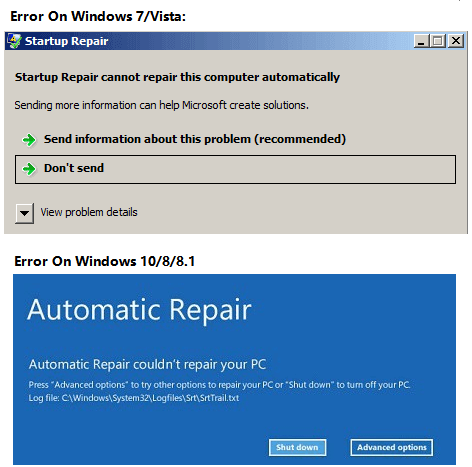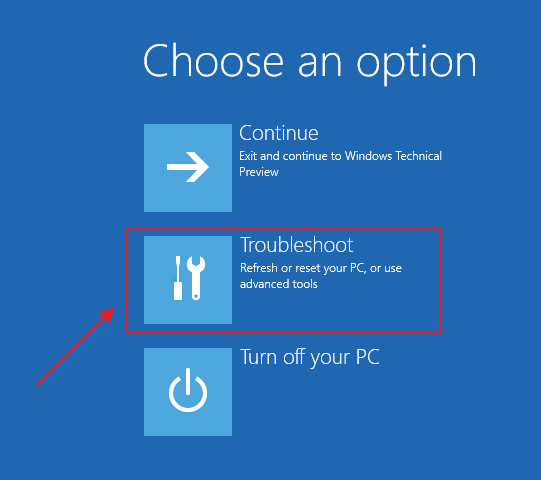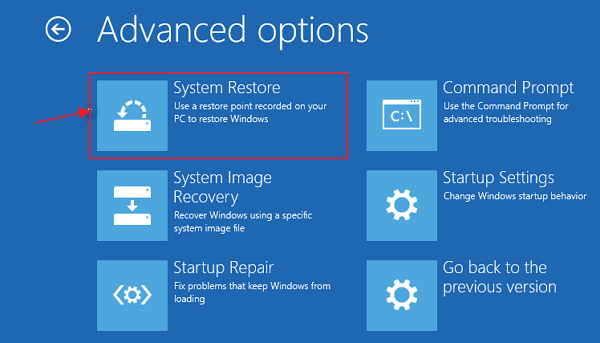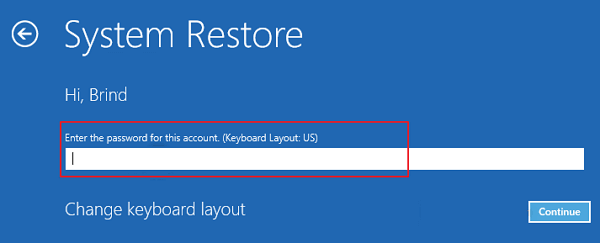On this page, we collected six fixes for you to get rid of the "Startup repair cannot repair this computer automatically" error on Windows 10/8/7 with step-by-step tutorial guides.
| Workable Solutions | Step-by-step Troubleshooting |
|---|---|
| Fix 1. Remove Peripheral Devices | If you have recently attached a device to your computer, remove the device...Full steps |
| Fix 2. Run Bootrec.exe | Restart your computer and press "F8", then choose "Repair Your Computer"...Full steps |
| Fix 3. Run CHKDSK | Restart your computer, choose "Repair Your Computer" > "Command Prompt"...Full steps |
| More Fixes | Restart your computer. Once it starts, press "F8", choose "Safe Mode with Command Prompt"...Full steps |
"Startup Repair cannot repair this computer automatically"
Startup Repair is a built-in Windows tool that can check and replace your computer's missing or damaged system files. Generally, this tool is applied when your computer cannot boot properly. However, many users have encountered an issue while using this utility: "Startup Repair cannot repair this computer automatically". This is the error message in Windows 7 or Windows Vista. Windows 10's equivalent is "Automatic Repair couldn't repair your PC".

You will see the information below if you click "View problem details" in Windows 7/Vista. (The problem signature might be shown different variables from the ones above on other OS.)
Problem Event Name: StartupRepairOffline
Problem Signature 01: 6.1.7600.16385
Problem Signature 02: 6.1.7600.16385
Problem Signature 03: unknown
Problem Signature 04: 21200442
Problem Signature 05: AutoFailover
Problem Signature 06: 65
Problem Signature 07: CorruptFile
OS Version: 6.1.7600.2.0.0.256.1
Locale ID: 1033
Then why did Startup Repair fail to work? Generally, when you receive the error message, it may indicate:
- There is a problematic device attached to your computer
- The file system of your system disk is damaged
- The MBR (Master Boot Record) of the hard drive is corrupted
- There may be virus attacks, disk write errors or power outages on your disk
🚩Read Also: How to Fix Your PC Did Not Start Correctly | 8 Ways🔥
6 Fixes for "Startup Repair cannot repair this computer automatically" in Windows 10/8/7
If you cannot specify the cause of why Windows Startup Repair failed, never mind trying the simple fixes first, and then, use some Windows 10 boot repair tools.
Method 1. Remove Peripheral Devices
Based on the information given by Microsoft, if you have recently attached a device to your computer, like a camera or portable music player, you can remove the device and restart your computer. Sometimes, Windows cannot repair the computer automatically due to the device being connected.
If this tip doesn't work, don't get upset. There are many other ways for you to try.
Method 2. Run Bootrec.exe
Bootrec, also called bootrec.exe utility, is a tool Microsoft provides in the Windows Recovery Environment. Bootrec.exe can fix the Master Boot Record (MBR), Boot Sector, Boot Configuration (BCD), and boot.ini. If the corrupt MBR or BCD caused the problem, the solution is to correct the MBR or BCD record with the help of bootrec. By the way, this method requires a Windows recovery disk. Since you are using it when you perform a startup repair, you can run bootrec.exe following the steps below.
In Windows 7:
Step 1. Restart your computer and press "F8" once you see the Windows logo.
Step 2. Among the advanced boot options, choose "Repair Your Computer".
Step 3. In the system recovery options, choose "Command Prompt".
Step 4. Enter the commands below in order:
bootrec /fixmbr
bootrec /fixboot
If the bootrec command fails, relax and you may follow this guide for help: Getting Bootrec /Fixboot Access Is Denied Error? Roundup Solutions.
Method 3. Run CHKDSK
As mentioned, bad sectors and file system errors on your hard drive may be why you receive the error message "Startup Repair cannot repair the computer automatically". Running CHKDSK can check and repair your disk errors, including bad sectors and file system errors.
Step 1. Restart your computer and press "F8" once you see the Windows logo.
Step 2. Among the advanced boot options, choose "Repair Your Computer".
Step 3. In the system recovery options, choose "Command Prompt".
Step 4. Enter the command below: chkdsk C: /f /r
"C" is the drive letter of your Windows installation drive.
Method 4. Run Windows System File Checker Tool
Windows System File Checker Tool can check and repair your computer's missing or corrupted Windows system files. Besides, using this tool doesn't need the Windows installation CD. All you need is to boot into the Safe Mode with Command Prompt.
Step 1. Restart your computer. Once it starts, press "F8" in 1-second intervals until you see the Windows logo.
Step 2. Then you will see the menu of "Advanced Boot Options". Under it, choose "Safe Mode with Command Prompt".
Step 3. In Command Prompt, enter the following command: sfc /scannow /offbootdir=d:\ /offwindir=d:\windows
Step 4. Restart your computer.
Read Also: SFC scannow There is a system repair pending
Method 5. Perform System Restore
If you've created a Windows system restore point as a system backup on your Windows 10/8/7 PC, you can fully restore it to its original state, at least to its previous state. System Restore is a feature in Microsoft Windows that allows users to revert their computer's state (including system files, installed applications, Windows Registry, and system settings) to a previous point. Thus, it can be used to recover from system malfunctions or other problems.
Procedure 1. Restore Important Data from the Dead PC
When you are stuck with the "Startup Repair cannot repair this computer automatically" or '"Automatic Repair couldn't repair your PC" error message on Windows PC, don't rush to perform System Restore. Performing a system restore will take your PC back to an earlier point, called a system restore point. Restore points are generated when you install a new app, driver, or Windows update and manually create a restore point. Restoring won't affect your personal files but will remove apps, drivers, and updates installed after the restore point was made. Therefore, we highly recommend you to try powerful data recovery software - EaseUS Data Recovery Wizard with Bootable Media to get your data out of the current 'dead' PC:
Notice: This will require a second healthy computer for help.
Procedure 2. Perform a System Restore
Suppose you have enabled the System Restore on your computer and created a system restore point. In that case, you can fix "Startup repair cannot repair this computer automatically" in Windows 10/8/7/Vista by performing a system restore:
For Windows 10/8/8.1 users:
Step 1. Reboot your Windows 10/8 PC into Advanced Startup, and click "Troubleshoot".

Step 2. Select "Advanced options", and choose "System Restore".

Step 3. Click on the Administrator Account, enter your password, and click "Continue" to move on.

Step 4. Choose your system restore point created previously and follow the on-screen guidelines to complete the process.
For Windows 7/Vista Users:
Step 1. Insert your Windows installation CD or disc.
Step 2. Press any key when the "Press any key to boot from CD or DVD" message appears.
Step 3. Select a language, time, currency, and keyboard or input method, and then click "Next".
Step 4. Click "Repair your computer".
Step 5. Select your Windows installation drive, usually C:\, and click "Next".
Step 6. In the System Recovery Options Dialog Box, click on "System Restore".
Step 7. Follow the System Restore Wizard instruction and choose the appropriate restore point.
Step 8. Click "Finish" to restore the system.
Finally, restart your computer and copy your restored data to your PC. You should be able to use your computer and data again.
Method 6. Repair Startup Error Without System Backup
If you don't have a system backup, fixing the "Startup Repair couldn't repair your PC" error will be more complex. You can:
Procedure 1. Restore the Problem PC
You can follow the detailed guidelines above to rescue your data with the help of EaseUS Data Recovery Wizard with Bootable Media. It fully lets you recover data when the PC doesn't boot or start in Windows 10/8/7/Vista.
Procedure 2. Clean Install/Reinstall Windows OS
When you don't have a system restore point on your PC, the best way to remove the 'Startup Repair' error on Windows 10/8/7, etc., is to install Windows OS cleanly. You can directly turn to Microsoft for online assistance (and Windows 7/Vista users are recommended to try this way). Or you can refer to the article about clean installing Windows 10.
How to Prevent "Startup Repair cannot repair this computer automatically" Error
Restoring your PC to life and rescuing all precious data doesn't mean that your PC and data are safe now. Virus attack, system failure, system crash, data loss, and other unknown issues may occur anytime. How to prevent these issues from happening? That isn't easy! Is it possible to protect your System and data securely from these disasters? Sure!
Powerful Windows system backup software - EaseUS Todo Backup can help. It provides System Backup, File Backup, Disk/Partition Backup, System Clone, and other more advanced features to help you fully protect your PC from these issues. It will help you prevent and protect your computer from 'Startup Repair failure' errors or similar problems. Making a backup is always the best way to avoid complete data loss.
The Bottom Line
"Startup Repair cannot repair this computer automatically" is a relatively complex issue related to Windows. Although there are solutions to the problem, they may not be easy to apply since these operations are seldom taken during your daily use. If you don't want to try it, you can send your computer to professionals for manual repair.
Was This Page Helpful?
Oliver is an EaseUS professional writer who dares explore new areas. With a passion for solving tech issues with straightforward guides for common users, Oliver keeps honing his writing craft by developing in-depth solutions for disk and partition management, computer boot-up issues, file transfer, etc.
Written by Tracy King
Tracy became a member of the EaseUS content team in 2013. Being a technical writer for over 10 years, she is enthusiastic about sharing tips to assist readers in resolving complex issues in disk management, file transfer, PC & Mac performance optimization, etc., like an expert.
Related Articles
-
The First Descendant Save File Location & Config File Location
![author icon]() Jerry/Jul 04, 2025
Jerry/Jul 04, 2025 -
How to Recover Overwritten Word Document No Previous Version [Full Ways]
![author icon]() Cedric/Jul 04, 2025
Cedric/Jul 04, 2025 -
![author icon]() Jean/Jul 04, 2025
Jean/Jul 04, 2025 -
Recover Not Showing Up/Disappeared User Folder and Files in Windows 10
![author icon]() Tracy King/Jul 04, 2025
Tracy King/Jul 04, 2025